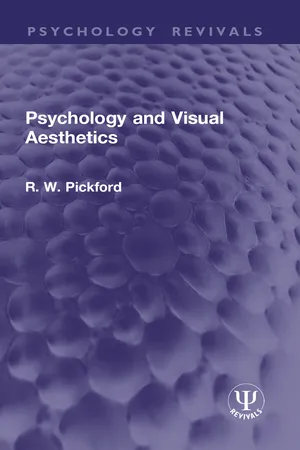
- English
- ePUB (mobile friendly)
- Available on iOS & Android
Psychology and Visual Aesthetics
About this book
Originally published in 1972, the aim of Psychology and Visual Aesthetics was to present a study mainly concerned with experimental work on visual aesthetics. From the rather restricted approaches of Fechner, the pioneer of experimental aesthetics, whose book Vorschule der Aesthetik was published in 1876, there had been a spread of interest out of the confines of the psychological laboratory to statistical studies, personality problems and social psychology. Although not a history of experimental aesthetics is was hoped that the various phases of development would be apparent, as follows: at first laboratory studies, mainly on individuals; then statistically oriented studies with numbers of subjects; in the 1940s the beginnings of the mathematical analysis of aesthetic judgments; then the introduction of personality studies, including the problems of the aesthetic judgments of psychiatric patients; and in the 1950s and 1960s the development of studies based on social psychology and the cross-cultural approaches.
These changes had taken place, hand in hand with developments in psychology as a whole and of psychological techniques, as will be evident in the chapters that follow. The changes correspond to the successive developments of Fechnerian experimental work, then of Gestalt Psychology, then intelligence tests and tests of special capacities and abilities, then personality tests and the understanding of abnormal psychology, and finally the expansion of research into what was now often called experimental social psychology. Today it can be read in its historical context.
This book is a re-issue originally published in 1972. The language used is a reflection of its era and no offence is meant by the Publishers to any reader by this re-publication.
Frequently asked questions
- Essential is ideal for learners and professionals who enjoy exploring a wide range of subjects. Access the Essential Library with 800,000+ trusted titles and best-sellers across business, personal growth, and the humanities. Includes unlimited reading time and Standard Read Aloud voice.
- Complete: Perfect for advanced learners and researchers needing full, unrestricted access. Unlock 1.4M+ books across hundreds of subjects, including academic and specialized titles. The Complete Plan also includes advanced features like Premium Read Aloud and Research Assistant.
Please note we cannot support devices running on iOS 13 and Android 7 or earlier. Learn more about using the app.
Information
Table of contents
- Cover
- Half Title
- Title Page
- Copyright Page
- ‘Driving out the Demon’
- Original Title Page
- Original Copyright Page
- Dedication
- Table of Contents
- Illustrations
- Preface
- Acknowledgements
- 1 Introduction: the psychological approach
- 2 Form perception and art
- 3 Haptic perception and the art of the blind
- 4 Colour perception and colour preferences
- 5 Colour vision defects and pictorial art
- 6 Experiments with pictures
- 7 Racial and cultural comparisons
- 8 Children’s aesthetic judgments
- 9 Personality and aesthetic preferences
- 10 Art and aesthetics, and future research
- Conclusions
- Index